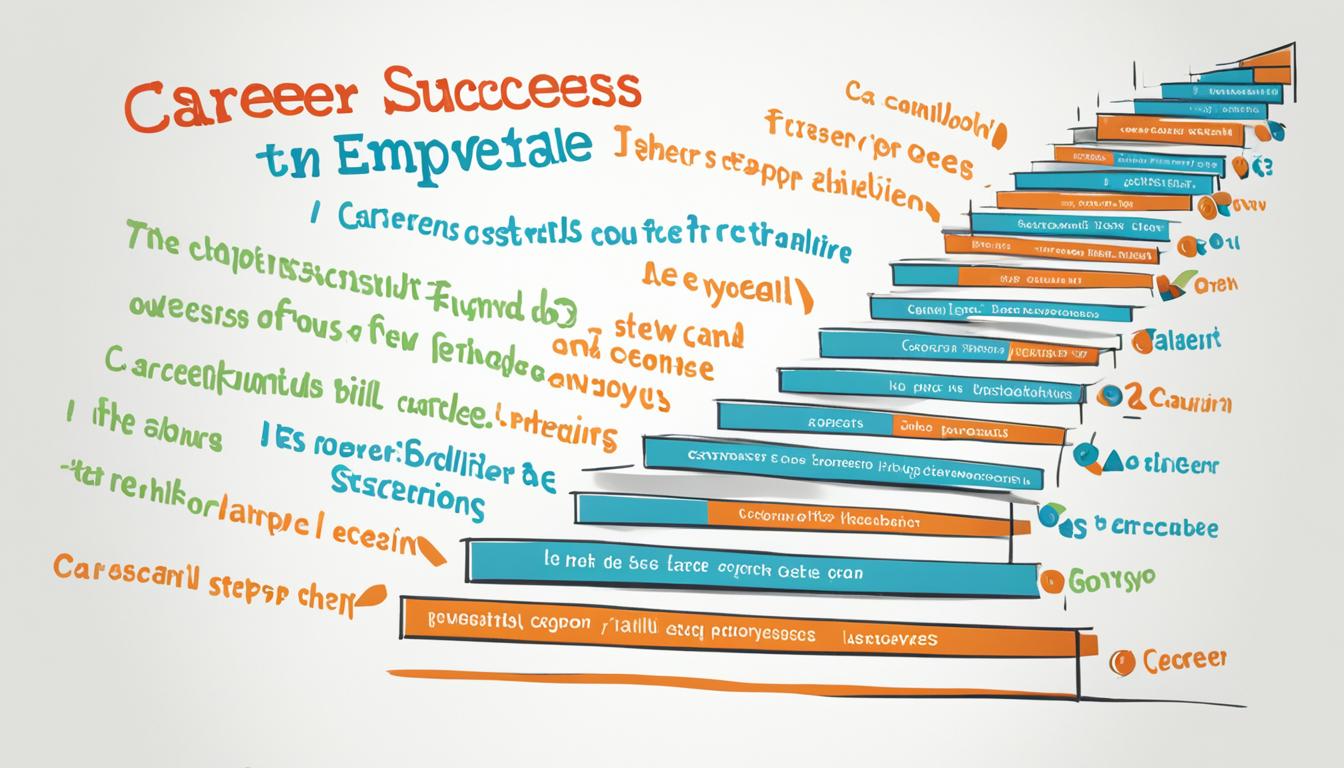Empower Your Career with Achievable Employee Goals

Are you looking to take your career to new heights? Do you want to unlock your full potential and achieve remarkable success? The key lies in setting and achieving employee goals. In today’s fast-paced and competitive work environment, having clear objectives and a roadmap for professional development is essential.
Setting employee goals allows you to define your performance targets, identify career growth milestones, and strive towards personal achievement. It provides you with direction, motivation, and a sense of purpose in your work. But what exactly are employee goals, and why are they so important?
- Employee goals are specific objectives that individuals aim to achieve within a certain timeframe.
- Setting clear goals enhances productivity, aligns individual efforts with organizational objectives, and provides a framework for performance reviews.
- Goal tracking software and tools can streamline the process of setting and managing employee goals.
- Effective goal setting is crucial for personal growth, professional development, and organizational success.
- Supporting employees in achieving their goals leads to increased job satisfaction, retention, and loyalty.
The Benefits of Setting Employee Goals
Setting employee goals offers numerous benefits for both individuals and organizations. By providing a clear path and motivation for employees to achieve their objectives, goal setting improves performance and drives overall success. Let’s explore the key benefits:
- Performance Improvement: Setting goals allows employees to focus their efforts, prioritize tasks, and work towards specific outcomes. This clarity enables them to perform at their best and achieve higher levels of productivity.
- Employee Engagement: When employees have clear goals, they feel valued and supported in their personal and professional growth. This sense of purpose and contribution boosts their engagement, leading to increased job satisfaction and a stronger commitment to achieving organizational objectives.
- Skill Development: Goal setting encourages employees to pursue continuous improvement and develop new capabilities. By setting goals that challenge their existing skills, employees can expand their knowledge, expertise, and competencies, contributing to their own growth and the overall skillset of the organization.
- Employee Satisfaction: Clear goals provide employees with a sense of direction and purpose in their work. When employees understand how their individual goals align with the organization’s objectives, it enhances their satisfaction and fulfillment, resulting in a more positive work environment.
- Retention and Loyalty: Setting goals and supporting employees in their achievement fosters a sense of loyalty and commitment. When employees see opportunities for growth and development within the company, they are more likely to stay, reducing turnover and increasing retention rates.
- Alignment and Communication: Goal setting promotes alignment within teams and across the organization. Employees have a clear understanding of their role and how their efforts contribute to the larger picture. This alignment enables effective communication, collaboration, and coordination, driving improved job performance and organizational success.
To visualize the benefits of setting employee goals, refer to the table below:
| Benefits | Description |
|---|---|
| Performance Improvement | Setting clear goals improves employee performance, enabling them to prioritize tasks and work towards specific outcomes. |
| Employee Engagement | Clear goals create a sense of purpose and value, increasing employee engagement and job satisfaction. |
| Skill Development | Goal setting encourages employees to develop new skills and capabilities, enhancing their expertise and contributing to organizational success. |
| Employee Satisfaction | Understanding how their goals align with the organization’s objectives boosts employee satisfaction and fulfillment. |
| Retention and Loyalty | Setting goals and supporting employees in their achievement fosters loyalty and reduces turnover, increasing retention rates. |
| Alignment and Communication | Goal setting promotes alignment within teams and across the organization, enhancing communication and driving overall success. |

Unlocking Potential and Driving Success
Setting employee goals is a powerful strategy that unlocks the potential of individuals and drives collective success. By providing a sense of direction, fostering engagement, promoting skill development, and strengthening alignment, organizations can harness the full capabilities of their employees. The benefits of setting goals extend beyond individual performance to impact employee satisfaction, retention, and overall organizational success.
How to Set Effective Employee Goals
Setting effective goals for your employees is a critical step towards achieving organizational success. When done correctly, goal setting can align individual efforts with company objectives, foster collaboration, and drive employee engagement. To ensure that your employee goals are both impactful and achievable, follow these key strategies:
1. Align Goals with Company Objectives
Effective goal setting begins with aligning individual goals with the overall objectives of your organization. Identify how each employee’s contribution can support the company’s mission, vision, and values.
2. Collaborative Goal Setting
Collaboration empowers employees and enables them to take ownership of their goals. Involve your employees in the goal-setting process by encouraging their input and insights. This approach fosters a sense of ownership and commitment, increasing the likelihood of goal achievement.
3. Utilize SMART Goals Framework
SMART goals are specific, measurable, achievable, relevant, and time-bound. Utilizing this framework can help define clear objectives and provide a roadmap for success. Ensure that each goal is specific, measurable, and relevant to the employee and organization. Set realistic targets and establish deadlines to instill accountability and urgency.
4. Define Specific Objectives
Specificity is key when it comes to setting employee goals. Clearly articulate what needs to be achieved, why it is important, and how success will be measured. This clarity ensures that employees have a clear understanding of what is expected, preventing ambiguity and confusion.
5. Ensure Measurable Criteria
Measurable criteria allow for tracking progress and evaluating goal achievement. Define key performance indicators (KPIs) or metrics that will be used to measure success. This enables employees to monitor their progress and make necessary adjustments to stay on track.
6. Establish Achievable Targets
While setting ambitious goals is important, it’s equally important to ensure they are attainable. Goals that are too challenging can demotivate employees and hinder progress. Assess employees’ skills and abilities to set targets that are challenging yet realistic.
7. Relevance to Employee and Organization
Employee goals should be meaningful and relevant to both the individual and the organization. Consider employees’ aspirations, strengths, and areas for development when setting goals. When goals align with employees’ personal growth and contribute to the organization’s success, motivation and commitment increase.
8. Setting Time-Bound Deadlines
Deadlines create a sense of urgency and promote accountability. Establishing time-bound deadlines ensures that employees stay focused and prioritize their efforts effectively. Encourage employees to break down larger goals into smaller milestones with specific deadlines, enabling incremental progress and timely completion.
By following these guidelines, you can set effective employee goals that drive growth, productivity, and overall success. Remember, effective goal setting is an ongoing process that requires regular monitoring, feedback, and adjustments to ensure continued progress.
| Key Strategies for Setting Effective Employee Goals |
|---|
| Align goals with company objectives |
| Engage employees in collaborative goal setting |
| Utilize the SMART goals framework |
| Define specific objectives |
| Ensure measurable criteria |
| Establish achievable targets |
| Relevance to both employee and organization |
| Set time-bound deadlines |
Examples of Employee Goals
Setting employee goals is a powerful way to drive personal growth, enhance professional development, and achieve success in various areas of your organization. By establishing specific and measurable objectives, individuals can focus their efforts and make meaningful progress towards their goals. Here are some examples of employee goals that can inspire and guide you on your journey:
1. Personal Growth Goals
- Developing creativity: Explore new hobbies, take art classes, or engage in activities that promote innovative thinking.
- Learning a new skill: Enroll in training programs or workshops to acquire additional knowledge and expertise.
2. Professional Development Goals
- Enhancing leadership skills: Seek opportunities to lead projects or teams, attend leadership seminars or workshops, and read books on effective leadership.
- Improving technical expertise: Take online courses or certifications to enhance your technical skills in areas relevant to your role.
3. Team-Focused Goals
- Improving collaboration: Actively participate in team meetings, share knowledge and ideas, and contribute to a positive team environment.
- Boosting team performance: Set targets to increase productivity, establish efficient workflows, and encourage teamwork.
4. Sales and Marketing Goals
- Increasing sales revenue: Set monthly or quarterly targets to improve sales performance and explore new strategies to attract customers.
- Boosting website traffic: Implement SEO techniques, create compelling content, and engage in digital marketing campaigns to drive more traffic to your website.
- Enhancing customer satisfaction: Establish metrics to measure customer satisfaction levels and identify areas for improvement in product or service delivery.
Remember, the key to effective goal setting is to make them specific, measurable, achievable, relevant, and time-bound (SMART). This will ensure that your goals are clear, actionable, and aligned with both your personal aspirations and the objectives of your organization.

The Importance of Tracking and Reviewing Employee Goals
Tracking and reviewing employee goals is crucial to ensure progress and evaluate performance. By regularly reviewing goals, managers can provide valuable feedback and recognition, motivating employees to improve their performance and achieve their objectives. This process not only boosts individual growth but also aligns with the overall organizational objectives.
Segmenting goals by department, team, or individual allows for a more focused approach, ensuring that each employee’s objectives are in line with the company’s goals. This segmentation enables managers to provide more specific guidance and support, leading to better outcomes and increased job satisfaction.
To drive motivation and incentivization, it is essential to set clear and challenging goals. When employees are given meaningful targets to strive for, it not only enhances their performance but also fosters a sense of ownership and accomplishment. This, in turn, boosts job satisfaction and loyalty, leading to higher retention rates and overall employee satisfaction.
The Power of Performance Evaluation and Feedback
Performance evaluation plays a key role in tracking and reviewing employee goals. It allows managers to assess the progress made by employees and identify areas for improvement. By providing constructive feedback during these evaluations, managers can guide employees towards effectively achieving their goals and addressing any challenges or shortcomings.
Recognition is another important aspect of the evaluation process. Recognizing and celebrating employees’ achievements not only boosts morale but also reinforces the importance of goal attainment. When employees feel valued and appreciated, their motivation and overall satisfaction increase, creating a positive work environment.
By implementing a robust system for tracking, reviewing, and evaluating employee goals, organizations can foster a culture of continuous improvement, driving individual and collective success.
Segmentation of Goals for Effective Alignment
Segmenting goals based on departments, teams, or individuals is crucial for effective goal alignment. This approach ensures that each employee’s objectives contribute directly to the organization’s desired outcomes. It enables managers to provide tailored guidance, allocate resources effectively, and identify potential roadblocks.
Segmentation also helps identify trends and patterns within different areas of the organization. By analyzing the progress and outcomes of segmented goals, managers can gain insights into the strengths and weaknesses of specific teams or departments. This valuable information can then be used to implement targeted improvements and drive overall organizational success.
Motivation, Incentivization, and Job Satisfaction
Motivation is a key factor in employees’ ability to achieve their goals. Setting clear and challenging objectives provides employees with a sense of purpose and direction, increasing their motivation and commitment to success. Additionally, effective goal tracking and regular feedback allow employees to stay on track and make any necessary adjustments along the way.
Incentivization further enhances motivation by providing tangible rewards for goal achievement. Rewards can range from financial incentives to career development opportunities or even public recognition. By linking goal attainment to these incentives, organizations can create a culture of high performance and continuous improvement.
Ultimately, the combination of motivation, incentivization, and effective goal tracking leads to increased job satisfaction. When employees feel their efforts are recognized and rewarded, they are more likely to feel fulfilled and committed to their roles. This, in turn, leads to higher levels of loyalty, retention, and overall satisfaction within the organization.
Image:
![]()
Supporting Employees in Achieving Their Goals
Supporting employees in achieving their goals is essential for their growth and success. By providing the necessary resources, feedback, and opportunities, organizations can empower their employees to reach their full potential.
One effective way to support employees is through regular 1:1 meetings. These meetings provide a dedicated time for managers and employees to communicate openly, address any concerns, and provide feedback on progress. It fosters a strong relationship between managers and employees, ensuring that everyone is on the same page and working towards the same objectives.
In addition to regular meetings, organizations should also focus on creating feedback and growth opportunities. Constructive feedback helps employees identify areas for improvement and provides guidance on how to enhance their skills. By offering growth opportunities such as workshops, training programs, and mentorship, organizations can foster continuous development and create a culture of learning.
Encouraging employees to pursue their passions and aligning their personal goals with their career development plans is another way to support their growth. When employees are able to pursue what they are passionate about, they are more motivated, engaged, and fulfilled in their work. By integrating their personal goals into their career advancement plans, organizations can create a fulfilling and purpose-driven work environment.
Career advancement opportunities play a crucial role in supporting employees. Organizations should provide clear paths for growth and advancement, offering stretch assignments and challenging projects that allow employees to expand their skills and knowledge. By promoting internal mobility, employees have the opportunity to explore different roles within the organization, contributing to their overall career advancement.
Supporting Employees – Key Strategies
Listed below are key strategies to support employees in achieving their goals:
- Regular 1:1 meetings for effective communication and feedback.
- Providing feedback and growth opportunities for continuous development.
- Encouraging employees to pursue their passions and aligning personal goals with career plans.
- Offering career advancement opportunities and stretch assignments.
- Promoting internal mobility for exploration of different roles.
By implementing these strategies, organizations can create an environment that supports employee growth, satisfaction, and success.

Comparison of Support Strategies
| Support Strategy | Benefits |
|---|---|
| Regular 1:1 meetings | – Improved communication – Timely feedback – Addressing concerns |
| Feedback and growth opportunities | – Skill development – Continuous improvement – Personalized guidance |
| Pursuing passions and aligning goals | – Increased motivation – Higher engagement – Fulfillment in work |
| Career advancement opportunities | – Skill expansion – Progression and growth – Retention of top talent |
| Internal mobility | – Broadened experience – Versatility and adaptability – Retention of diverse skills |
By adopting these support strategies, organizations can create a culture that prioritizes employee growth and development, leading to a more dynamic and skilled workforce.
The Role of Goal Setting in Employee Satisfaction and Company Success
Goal setting plays a crucial role in enhancing employee satisfaction and contributing to company success. When employees have clear goals, they gain direction, motivation, and a sense of purpose in their work.
Having well-defined goals leads to increased employee satisfaction as individuals have a clear understanding of what they need to achieve and how their efforts contribute to the larger organizational objectives. When employees see the alignment between their goals and the company’s goals, it improves teamwork and overall job performance. It fosters a sense of belonging and collective effort.
Furthermore, goal setting enhances productivity by providing employees with a roadmap to success. They can prioritize tasks, develop action plans, and make progress towards their goals. This focus and clarity increase efficiency and effectiveness, ultimately driving organizational success.
Employee satisfaction and retention are closely linked to effective goal setting. When employees feel their goals are achievable and aligned with their personal growth, they are more likely to feel fulfilled in their roles and stay committed to the organization. Companies that support the achievement of employee goals are more likely to retain their top talent and build loyalty and dedication.
Customer service and profitability are also influenced by goal setting. By setting clear goals related to customer satisfaction and service excellence, employees can deliver exceptional experiences to customers, leading to increased loyalty and repeat business. Meeting financial targets and driving profitability can also be facilitated through goal setting, as it focuses employees on key performance indicators and revenue generation strategies.
Alignment and communication are integral components of goal setting. When goals are aligned with the overall mission and vision of the company, employees can see their contributions in the larger context. This alignment fosters a sense of purpose and engagement. Effective communication around goals ensures that employees understand expectations, receive feedback, and have the resources they need to succeed.
Overall, goal setting is a powerful tool for enhancing employee satisfaction and driving company success. It provides employees with direction, motivation, and a sense of purpose, leading to increased productivity and achievement. By aligning goals with organizational objectives and fostering effective communication, companies can create a positive and thriving work environment that promotes engagement, retention, and ultimately, organizational success.
Conclusion
Setting and managing employee goals is the key to unlocking personal and professional growth, and driving organizational success. When goals are aligned with company objectives, employees feel a sense of purpose and direction, leading to a culture of achievement and continuous improvement. By utilizing the SMART goal framework, organizations can ensure that these goals are specific, measurable, achievable, relevant, and time-bound.
Supporting employees in achieving their goals is equally important. Regular feedback, growth opportunities, and career advancement can foster a sense of job satisfaction, increase retention rates, and cultivate loyalty. When employees feel valued and supported in their personal and professional development, they are more likely to contribute to the overall success of the company.
Goal setting also plays a crucial role in effective communication and productivity. When teams and individuals understand how their efforts contribute to the larger organizational objectives, it leads to improved teamwork, better performance, and enhanced alignment. Ultimately, goal setting empowers employees, drives productivity, and paves the way for successful communication and organizational achievements.






